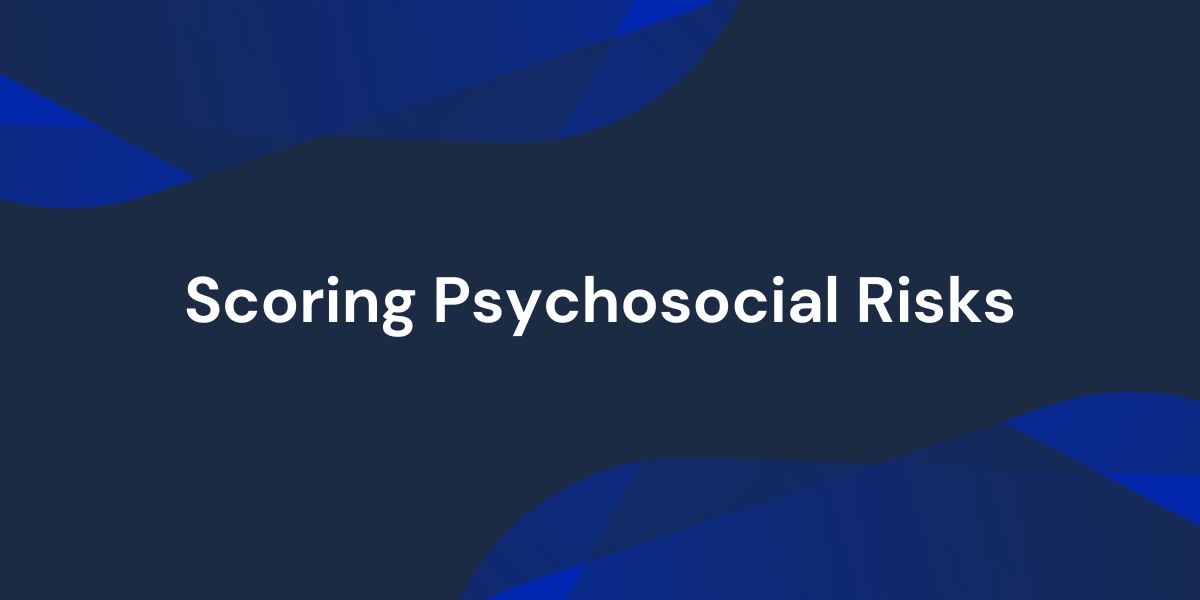
Our methodology for scoring psychosocial hazards is designed to provide a systematic way to measure and address potential risks in the workplace. This process includes two main components: Subjective Impact (consequence) and Prevalence (likelihood), which when combined, produce an overall Combined Risk Score for each psychosocial risk category.
Subjective Impact (or consequence)
This measure evaluates the personal impact of the psychosocial hazard on an individual. It is calculated using three key factors:
- Feeling: Individuals rate their current emotional state from a list, where each emotion is scored between 1 and 5 based on its severity.
- Intensity of Feeling: The strength of the emotion is also scored between 1 (mild) to 5 (strong).
- Functioning: The individual’s self-reported ability to function effectively, despite the feelings, scored from 1 (well) to 5 (not well at all).
The average of these scores, depending on which factors are reported, provides a weighted measure of the subjective impact of the hazard.
Prevalence (or likelihood)
This aspect measures how widespread the hazard is within the organisation:
- % of Staff Reporting the Hazard: We assign scores based on the percentage of staff that have reported the hazard, with thresholds ranging from less than 5% to over 20% (example).
- Duration/Frequency: This considers how long the hazard has been affecting the staff, scored from 1 (just today) to 5 (for as long as I can remember).
A combination of these scores, averaged over a period, quantifies the prevalence of the hazard.
Combined Risk Score
The final risk score is calculated by multiplying the Subjective Impact score by the Prevalence score. This combined score is then used to position the hazard on a risk matrix, which helps determine the necessary actions or interventions.
5×5 risk matrix (the most widely adopted scoring approach is 5×5 and this is important)

Thresholds for determining next steps

Feeding into your safety system

Skodel recommends managing psychosocial risks centrally through your organisation’s existing WHS risk management system. The Skodel Hazard Identification Survey provides validated, regulator-aligned data that can be directly linked to your risk register to maintain a consistent and defensible approach.
Where integrations are active, Skodel can automatically feed survey data into your central risk register. Where integration is not yet established, the data should be used as a key input during regular risk reviews to inform updates and decision-making.
Skodel recommends the following approach:
.png)
- Central management: Manage psychosocial risks within your existing WHS risk register to ensure alignment and oversight across all hazard categories.
- Mapping exercise: Skodel works with your team to map each psychosocial hazard from the survey to corresponding risk register categories (e.g. consequence/likelihood, or severity/frequency) so that language and scoring remain consistent with your framework.
- Integration: Where possible, enable automated data feeds or exports (via CSV, JSON, or API) to update psychosocial risk entries.
- Terminology alignment: If your organisation uses different terminology (e.g. “Consequence and Likelihood” instead of “Impact and Prevalence”), Skodel will map its scoring to those terms to ensure consistency and clarity across reporting.
- Risk review: Use Skodel’s survey data as a key source when reviewing your register to determine:
- if risk levels need to change,
- if existing controls are effective, and
- where additional actions are required.
- Evidence base: Skodel will retain results and consultation logs as supporting evidence for each hazard entry, showing how the risk rating was determined and providing a clear audit trail.
This approach ensures psychosocial hazards are assessed, recorded, and monitored in a way that aligns with your broader WHS risk management framework.
Expert oversight
- Martyn Campbell – former Executive Director of SafeWork SA, widely recognised for his expertise in psychosocial risk regulation.
- Andrew Fuller – clinical psychologist and Fellow at the University of Melbourne, with decades of experience in education and resilience research.
Both have worked alongside Skodel in developing and refining the way psychosocial risks are interpreted and reported.
Our approach is rooted in comprehensive research and practical application:
- Extensive Experience: Over 100,000 checks have been conducted, providing a robust data set that informs our scoring thresholds. These thresholds are critical to ensure accuracy in identifying real issues without over or underreporting.
- Expert Involvement:
- Clinical Psychologist: Provides expertise on emotional impact and the psychological aspects of the methodology.
- Organisational Psychologist: Focuses on the impact within the workplace context and how it affects overall organisational health.
- WHS Professional: Ensures that the methodology aligns with workplace health and safety standards and practices.
This methodology is focused on being accurate and expert-guided, ensuring a balanced and effective approach to managing psychosocial hazards in the workplace. Our aim is not just to score but to provide a clear framework for intervention and improvement, enhancing workplace safety and well-being
.png)
.png)
.png)